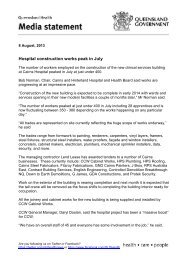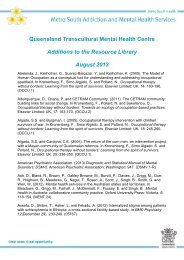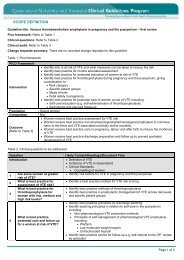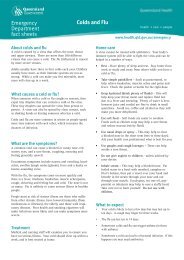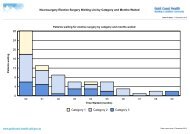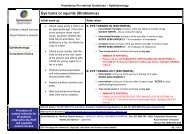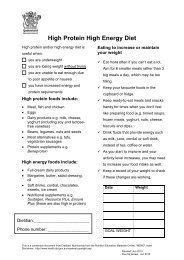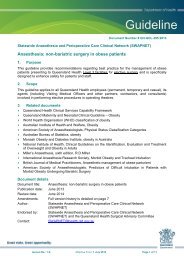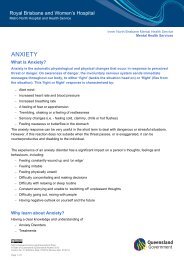Interviews How to arrange and conduct interviews - Queensland ...
Interviews How to arrange and conduct interviews - Queensland ...
Interviews How to arrange and conduct interviews - Queensland ...
Create successful ePaper yourself
Turn your PDF publications into a flip-book with our unique Google optimized e-Paper software.
<strong>Interviews</strong><br />
<strong>Interviews</strong> are usually <strong>conduct</strong>ed one-on-one (either face-<strong>to</strong>-face or by telephone)<br />
<strong>to</strong> obtain detailed information from participants, stakeholders <strong>and</strong> partners<br />
about their views on a project/program. This information is then used as part<br />
of planning <strong>and</strong>/or evaluating a project/program [99].<br />
<strong>Interviews</strong> can be:<br />
ÉÉ<br />
ÉÉ<br />
ÉÉ<br />
unstructured, by holding a normal conversation with follow-up questions<br />
at the time of the interview [99]<br />
semi-structured, by using a set of st<strong>and</strong>ardised questions [99]<br />
in-depth, by using only a <strong>to</strong>pic or discussion guide [99].<br />
<strong>How</strong> <strong>to</strong> <strong>arrange</strong> <strong>and</strong> <strong>conduct</strong> <strong>interviews</strong><br />
Select a coordina<strong>to</strong>r<br />
An interview coordina<strong>to</strong>r can be responsible for:<br />
ÉÉ<br />
ÉÉ<br />
ÉÉ<br />
ÉÉ<br />
ÉÉ<br />
ÉÉ<br />
pre-arranging the time <strong>and</strong> place for an interview [22, 99] (consider whether<br />
the interviewee will be more comfortable if in a familiar setting, which may<br />
require travel time)<br />
sending confirmation letters <strong>and</strong>, if desired, the interview questions beforeh<strong>and</strong><br />
booking interview rooms [22]<br />
making reminder telephone calls the day before the interview<br />
making thank you telephone calls after the interview<br />
sending thank you letters with a copy of the overall interview results.<br />
1
Develop interview questions or a discussion guide<br />
Interview questions gather an in-depth response <strong>and</strong> still allow other issues<br />
<strong>to</strong> be raised by the participant [99]. Interview questions:<br />
ÉÉ<br />
ÉÉ<br />
ÉÉ<br />
ÉÉ<br />
require more than a yes or no response [99]<br />
are open-ended questions that help <strong>to</strong> generate a lot of information [99]<br />
should not lead a response by implying the answer in the question [99]<br />
generally ask the who, what <strong>and</strong> how of an issue.<br />
Sample interview questions:<br />
ÉÉ<br />
ÉÉ<br />
ÉÉ<br />
ÉÉ<br />
ÉÉ<br />
ÉÉ<br />
Who in your organisation would be interested in being involved with the<br />
project/program?<br />
<strong>How</strong> do you think your organisation will use the project/program?<br />
What parts of the project/program will be the most use <strong>to</strong> your organisation?<br />
Who in your organisation has used the project/program?<br />
<strong>How</strong> do you feel about the project/program?<br />
What do you think are the effective parts/strongest points of the<br />
project/program?<br />
An interview discussion guide is generally used by a more experienced interviewer,<br />
<strong>and</strong> will only outline the main issues <strong>to</strong> be discussed [99]. It will also include probes<br />
or points <strong>to</strong> prompt for more information if issues are still unanswered [99].<br />
Interview questions need <strong>to</strong> be developed <strong>and</strong> tested <strong>to</strong> ensure they are:<br />
ÉÉ<br />
ÉÉ<br />
ÉÉ<br />
clear <strong>and</strong> simple<br />
easy <strong>to</strong> underst<strong>and</strong><br />
gather the information required [101].<br />
For more information on developing <strong>and</strong> testing interview questions, visit:<br />
ÉÉ<br />
Surveys/questionnaires (Step 6)<br />
Link <strong>to</strong> Phase 1 material: Surveys/ questionnaires<br />
2
Select the interviewer<br />
Decide who will <strong>conduct</strong> the <strong>interviews</strong> by considering:<br />
ÉÉ<br />
ÉÉ<br />
ÉÉ<br />
ÉÉ<br />
what impact the interviewer will have on the answers of participants [22]<br />
the confidentiality of the questions <strong>and</strong> whether you or someone in your<br />
organisation can do the <strong>interviews</strong> [22]<br />
whether any sensitive questions are being asked (eg. gender based or cultural<br />
issues) <strong>and</strong> if these will be answered honestly with the person selected <strong>to</strong><br />
<strong>conduct</strong> the <strong>interviews</strong> [101]<br />
whether participants will speak more freely if an external person is used<br />
(if so, you will probably need <strong>to</strong> pay someone <strong>to</strong> do the <strong>interviews</strong>) [22].<br />
Set up an interview procedure<br />
Design <strong>and</strong> follow an interview procedure <strong>to</strong> ensure all participants are being<br />
given <strong>and</strong> asked the same information, especially when there is more than one<br />
interviewer. This will st<strong>and</strong>ardise the way the interview is <strong>conduct</strong>ed [101]. The<br />
procedure could also contain the st<strong>and</strong>ard introduction that interviewers say <strong>to</strong><br />
participants <strong>and</strong> instructions on how <strong>to</strong> answer participants’ questions [101].<br />
At the start of an interview<br />
While keeping the introduction short <strong>and</strong> easy <strong>to</strong> underst<strong>and</strong>, address the<br />
following points at the start of an interview:<br />
ÉÉ<br />
ÉÉ<br />
ÉÉ<br />
ÉÉ<br />
ÉÉ<br />
ÉÉ<br />
ÉÉ<br />
ÉÉ<br />
the importance <strong>and</strong> purpose of the survey <strong>and</strong> the credibility of the<br />
organisation involved [101]<br />
the importance of the respondent’s participation [101]<br />
the time it will take <strong>to</strong> complete the interview [101]<br />
your assurance that their information is confidential (as appropriate)<br />
your appreciation for their valuable time <strong>and</strong> effort [101]<br />
a contact person’s name <strong>and</strong> details for further enquiries<br />
an offer for feedback of results [101]<br />
an explanation as <strong>to</strong> why they were selected <strong>to</strong> participate [101].<br />
In face-<strong>to</strong>-face <strong>interviews</strong>, make eye contact <strong>and</strong> smile [101]. In telephone<br />
<strong>interviews</strong>, make sure your voice sounds happy <strong>and</strong> friendly.<br />
3
During an interview<br />
When <strong>conduct</strong>ing the interview:<br />
ÉÉ<br />
ÉÉ<br />
ÉÉ<br />
ÉÉ<br />
ÉÉ<br />
ÉÉ<br />
run through your questions with the participants [22]<br />
be a good listener, <strong>and</strong> hear what the participants are saying (ie. not what you<br />
want <strong>to</strong> hear)<br />
allow participants time <strong>to</strong> think about the question <strong>and</strong> their responses<br />
ask the questions in the same way<br />
take notes during the interview, especially the key points a person is making<br />
thank participants for their time <strong>and</strong> involvement.<br />
If recording the interview (by either video or tape), seek written consent first <strong>and</strong><br />
remember <strong>to</strong> bring extra batteries <strong>and</strong> tapes.<br />
After an interview<br />
After the interview:<br />
ÉÉ<br />
ÉÉ<br />
read your notes <strong>to</strong> make sure they make sense <strong>and</strong> nothing important has<br />
been missed<br />
send a thank you letter <strong>and</strong> provide feedback of overall results <strong>to</strong> interested<br />
participants.<br />
You will also need <strong>to</strong> analyse the information that has been collected <strong>and</strong><br />
interpret the results. Writing a report allows you <strong>to</strong> share the information with the<br />
participants <strong>and</strong> others.<br />
For more information on analysing the information <strong>and</strong> interpreting the results, visit:<br />
ÉÉ<br />
Surveys/questionnaires (Step 8)<br />
Link <strong>to</strong> Phase 1 material: Surveys/ questionnaires)<br />
4
References<br />
1. Queensl<strong>and</strong> Health – Healthy Schools website, Health Promoting Schools<br />
Toolbox Booklet 6 – <strong>How</strong> <strong>to</strong> gather information. Accessed 2 March 2007.<br />
http://www.health.qld.gov.au/healthyschools/documents/29337.pdf<br />
2. Department of Health <strong>and</strong> Ageing. 2004. Building Healthy Communities.<br />
A guide for community projects. Toolkit. Australian Government. ISBN<br />
0624824649. Accessed May 2007.<br />
http://www.aodgp.gov.au/internet/wcms/publishing.nsf/Content/ruralhealthpubs-BHC-eval-more.htm<br />
Citation: Queensl<strong>and</strong> Health. 2007. Queensl<strong>and</strong> ‘Stay On Your Feet ® Community Good Practice<br />
Toolkit- Phase 1 materials: <strong>Interviews</strong>. Health Promotion Unit, Division of the Chief Health Officer,<br />
Queensl<strong>and</strong> Health.<br />
5



